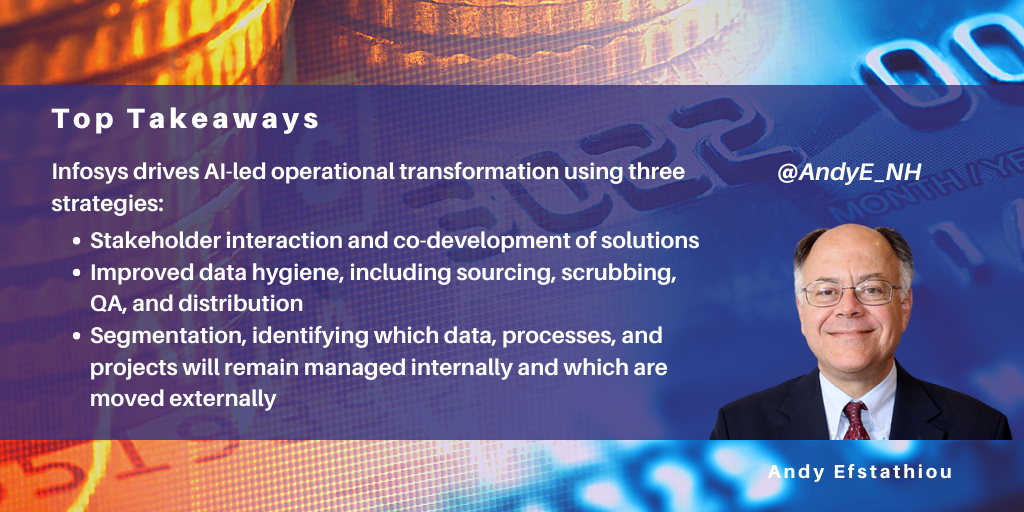Search posts by keywords:
Filter posts by author:
Related Reports
Related NEAT Reports
Other blog posts
posted on Mar 14, 2024 by Andy Efstathiou

NelsonHall recently attended the Infosys U.S. Analyst Day in Dallas, the theme of which was “Being AI First”. It demonstrated clear progress since last year’s conference in Infosys’ thinking and approach to the critical steps for effective implementation and operational deployment of AI.
Key components of AI-led operational transformation
Infosys and its clients attending the conference identified three essential components to enabling an effective AI-led operations transformation:
- Stakeholder interaction and co-development of problem definition, goals identification, roadmap development, and operations transformation
- Data hygiene, including sourcing, scrubbing, QA, and distribution
- Segmentation, identifying which data, processes, and projects will remain managed internally and which are moved externally.
To drive the first component of stakeholder interaction, Infosys pursues a hub-first strategy for innovation. Hubs are operational centers of expertise where Infosys and its clients work on client projects to develop novel POCs and operational deployments. Clients prefer to be involved in innovating their operations and have relevant input to shape and drive the innovation process. This enables a co-creation process that allows enterprises to focus on innovation at a higher success rate. Infosys values the feedback, domain expertise, and deep knowledge of an institution’s differentiating factors that clients provide in a hub environment.
To drive innovation in a tightly coupled co-creation environment, Infosys has built tech and innovation hubs worldwide. In the U.S., it had committed to building four hubs in 2018, but it has set up six because of client demand. The six hubs are based in Providence, RI; Richardson, TX; Hartford, CT; Raliegh, NC; Indianapolis, IN; and Phoenix, AZ.
The ideation from hubs needs to be realized with AI functionality and delivered with operational flexibility. To enable that synthesis, Infosys has coupled two of its platforms, Topaz (an AI-first offering that helps enterprises create value from generative AI technologies) and Cobalt (a set of services, solutions and platforms for enterprises to accelerate their cloud journey), to speed up ideation and the operationalization of successful POCs. This enables innovation at both speed and scale.
To continue growing its capabilities, Infosys is investing in AI to support operational transformation. Infosys’ significant investments in AI-led transformation are:
- Infrastructure-led transformation to the cloud
- Data and AI transformation leveraging the cloud
- Business transformation led by enterprise apps and SaaS
- Platform engineering
- Non-IT workloads to the cloud.
Infosys’ AI-first strategy for financial services
Infosys has built its most comprehensive domain-specific AI capabilities for the financial services industry. Financial services is the largest industry segment for Infosys (~30% of revenues), and North America is the largest single market (~60% of total revenues).
Infosys’ AI-first strategy for financial services focuses on nine areas it uses to help banks improve their business performance. The focus areas are:
- Personalization at scale for sales and marketing
- Deepening relationships by helping advisors work with customers
- Portfolio management and product design and testing
- Risk scoring for credit, AML, KYC, and onboarding
- Operations improving CX and employee experience
- Modernizing tech and infrastructure with AI
- Talent and change management
- Making the enterprise data ready.
Client use case
Infosys provided a use case of a credit union. The credit union has been committed to giving back to its employees and members, and had to identify how changing technology and member preferences could be fulfilled and achieved with new delivery techniques and offers. Data is the core of the financial services industry, And the credit union segmented its data into three areas:
- Foundational data: this is unchangeable data that should remain on-premises. Examples include identifier data and legally private data
- Core data: this data includes transaction data and transient entity data. Examples include KYC, AML, fraud, and transaction data. This data can be moved to the cloud
- Sales and marketing data: this data changes rapidly in response to changing market conditions and various product campaigns. This data should be kept in the cloud from the start because it has a very short lifespan. However, the research data supporting the campaigns comes from internal and external data and, therefore, should not be kept in the cloud.
Infosys identified 200 use cases to manage the data and drive better customer value. Cases were ideated, POCed, and operationalized in a disciplined waterfall where unpromising use cases were dropped. The primary driver of use cases that make it to full operational deployment is customer data rather than product data. The client started the initiative with employees and leveraged Infosys’ tools and support to enable it to develop offerings and delivery methodologies that appeal to a younger generation with differing priorities and needs than the older generation.
Summary
Intelligent automation and data transformation POCs and projects have gained traction over the past year, propelled by the GenAI opportunity and hype. Only some of the many POCs and MVPs have translated into operational transformation at scale. Infosys’ approach to using AI to drive operational change uses client co-creation to build differentiating operational change, data hygiene techniques to enable effective analysis, and rigorous segmentation of data, projects, and processes to set role-based responsibilities. This approach allows for change to happen quickly and at scale.
Infosys provided examples of how it delivers these services in the financial sector, including regional and local banks. These banks represent a larger addressable market for IT services vendors than tier-one banks because they have older legacy systems and will be less likely to retain as high a level of internal operations as the tier-one banks in the long run.
The challenge for vendors is to identify compelling value propositions for clients. Infosys has addressed this challenge with its localization initiatives that drive the co-creation of differentiated operational offerings at scale. Data drives the financial services industry, and Infosys’ activities with a credit union, described above, outline how a data transformation program can be handled.
